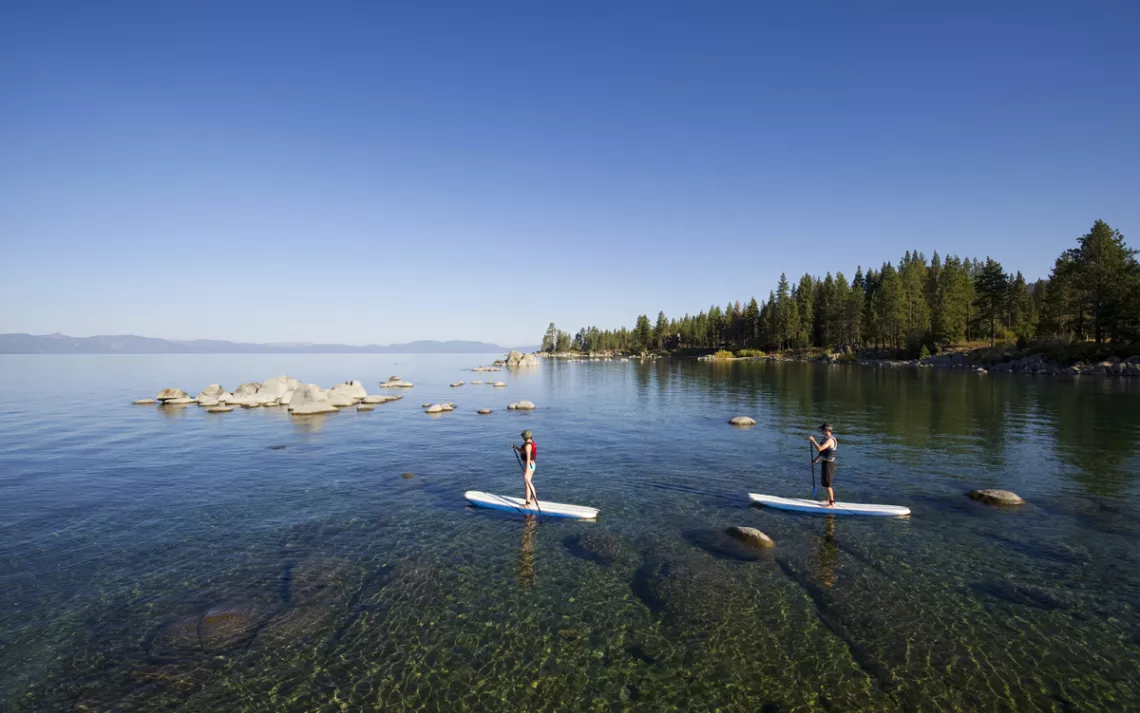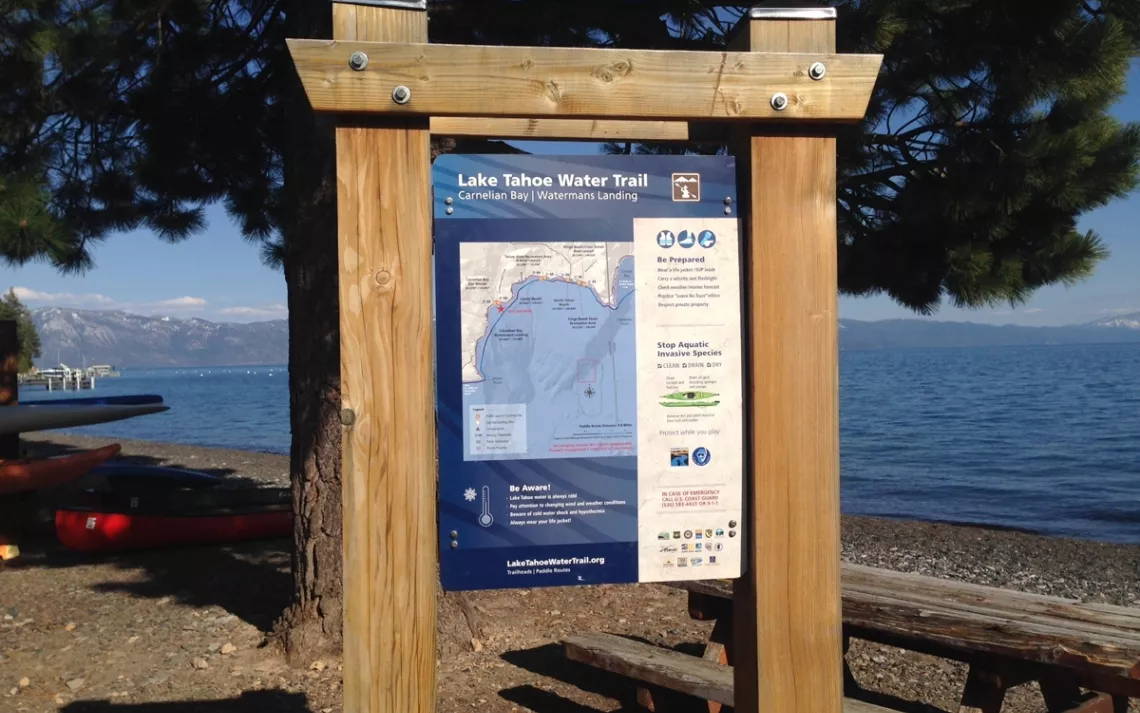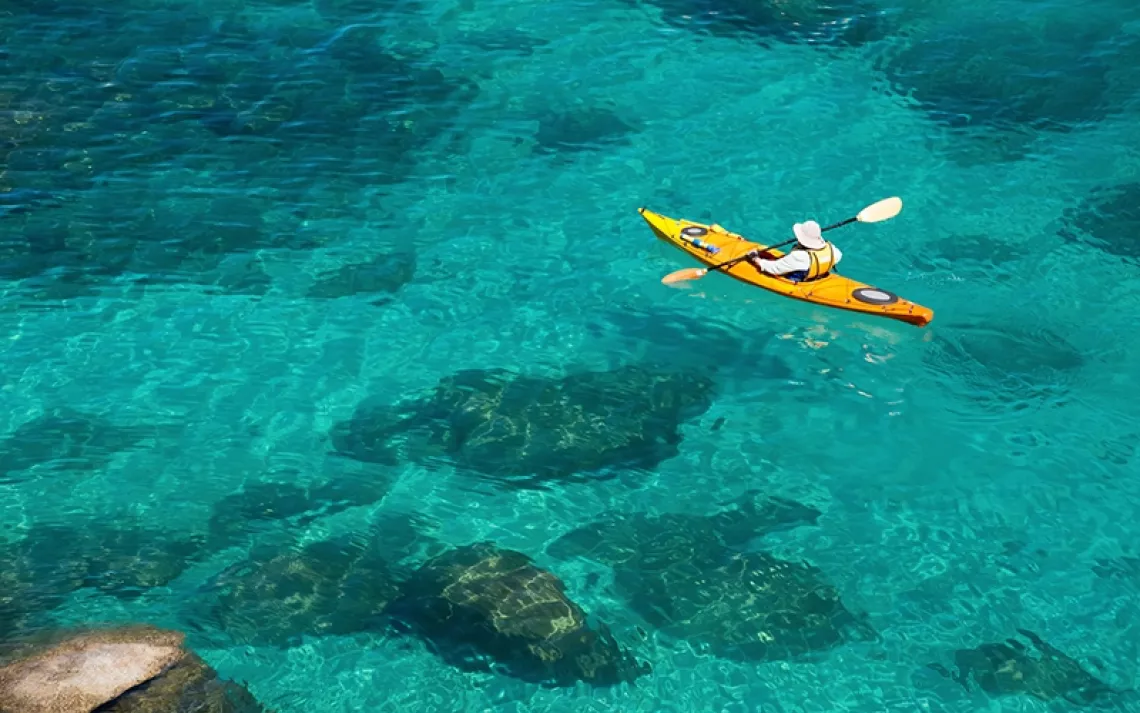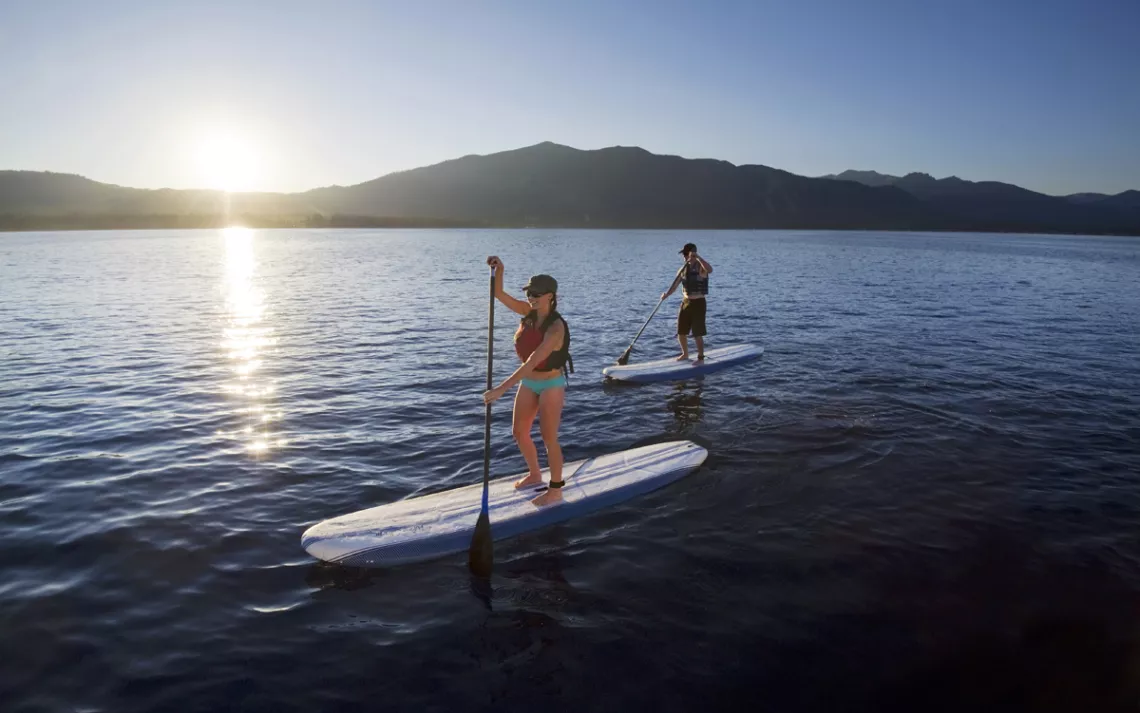The Trailhead at the Water’s Edge
The Lake Tahoe Water Trail offers adventurers slick mileage

Courtesy of Lake Tahoe Visitors Authority
The trailhead sign at South Lake Tahoe’s Camp Richardson Resort has all the usual features: map, campsites and restrooms, preparation essentials, environmental advice, and an emergency contact number. But this is no ordinary trailhead—it’s one of 20 on the Lake Tahoe Water Trail. To get on it, I walk down the beach, wade in up to my knees, stand up on my paddleboard, and head west toward Emerald Bay.
With more than 72 miles of shoreline, Tahoe is an ideal lake to explore from atop kayaks and stand-up paddleboards (SUPs). As temperatures rise, the winter mountain playground shifts its focus to the lake. Paddleboard and kayak rental opportunities abound, and public agencies in California and Nevada map out good launching spots for those seeking paddle sessions on the lake.
Water trails exist across the country. Like the Lake Tahoe Water Trail, they typically link launch sites, paddle shops, picnic areas, restaurants, campgrounds, and lodging facilities. The Lake Tahoe Water Trail Association has maps that break the route into seven segments, offering options for day trips as well as linked, multiday adventures.

Courtesy of the Lake Tahoe Water Trail Association
This morning, I’m armed with a life jacket, windbreaker, water, lunch, sunscreen, and the waterproof Lake Tahoe Water Trail Map & Guide. Tahoe’s trademark clear blue water stretches beyond me like an artist’s study of varying lighter and darker hues. Over the years, runoff, erosion, development, and air pollution have joined forces to dim the lake’s heralded clarity, reducing visibility further each year. Actions are under way to reverse this decline, but the challenge is enormous, and the future remains cloudy.
Less publicized than the Keep Tahoe Blue grassroots advocacy campaign promote comprehensive restoration of the watershed is the Tahoe Keepers’ quest to combat aquatic invasive species. The most serious threats to the area’s streams and lakes are hydrilla (an aquatic plant), zebra and quagga mussels, and New Zealand mud snails. Each of these invaders can collect in cockpits and hatches, cling to outer hulls, rudders, and paddles, and even hide within other types of water gear and debris.
As such, all nonmotorized rental watercraft available for use on the Lake Tahoe Trail is cleaned, drained, and dried between use. Since I’ve brought my own SUP from home, I’ve taken care of all that myself—it’s a small task to ensure the lake remains open and welcoming to fellow paddlers.

Courtesy of the Lake Tahoe Water Trail Association
With a variety of beaches on which to dock and take a breather, this trail offers plenty of opportunities to adjust a journey’s pace and truly savor the sights and sounds of Lake Tahoe. My only goal is to arrive at Emerald Bay State Park—six miles away—before the late afternoon winds kick in.
As I pass Kiva Beach at the mouth of Taylor Creek, it seems as if I have the surrounding mountains all to myself. Even now, in the warm summer months, a few peaks are frosted with snow, like a dessert topping.
Paddling past Taylor Creek, I strain to see the Stream Profile Chamber, a unique underground viewing chamber, where those traversing the lake’s adjacent Rainbow Trail often gather to watch a slice of the creek through aquarium windows. Native and non-native fish swim through the habitat, affording hikers access to the world beneath the surface. After passing Tallac Marsh, I peer down into the shallows, notice trout swimming below my board, and decide sitting down and dangling my bare feet into the fishes’ realm is the best way to enjoy the scenery.
Too lazy to pick my paddle up, I swirl my legs around to move away from the shallow water. As I retreat farther from shore, I notice the shades of blue deepen. In 2017, Lake Tahoe’s water depth clarity was measured at 59.7 feet (its depth averages 1,000 feet)—a 9.5-foot decrease from 2016. I look down, trying to gauge how deep my sight penetrates the lake. I stretch my toes to reach the fish, but they’re too far below me.
As a child, I traveled to Lake Tahoe every summer. Each evening, my sister and I would return to my uncle’s house on the Zephyr Cove shoreline tired, pruned, and waterlogged. But this stand-up paddling excursion is the first time I’ve really been on the water—not looking down at it from a boat or pier. Being part of the lake offers an otherworldly solitude I’ve not felt here before.
I keep my eyes open for eagles overhead while I paddle on, alongside towering mountains, and on past Eagle Creek and its waterfalls. Three hours after starting out on the trailhead, I arrive at my final destination. Emerald Bay Beach is a National Historic Landmark with 360-degree views of Emerald Bay (which may be one of Earth’s most photographed spots), Fannette Island, Eagle Falls, and Vikingsholm Castle, which was once the summer residence of philanthropist Lora Knight.
But thanks to my newfound sense of peace, I don’t want to get off the lake just yet. So I sit back down on my board, floating in the shallows, soaking in the sunlight as it sparkles on the water, and hatching plans to go out again tomorrow.

Courtesy of Lake Tahoe Visitors Authority
Follow in the Writer’s Footsteps
Where: Lake Tahoe shoreline from Camp Richardson Resort to Emerald Bay
Getting There: Use the Lake Tahoe Water Trail Association’s website to navigate the lake.
Best Time to Visit: Lake Tahoe paddle sports rentals are usually open from early to mid-May through early October. Depending on where you are, Lake Tahoe can be windy and wavy from about 2 to 5 P.M.; consider starting in the morning hours.
Eco Tips: Need a primer on how to keep aquatic invaders out of Lake Tahoe? Tahoe Keepers offers an online informational video and quiz. In addition, nonmotorized craft can be taken to any inspection station and decontaminated at no cost.
Survival Tips: Those blue hues are alluring, but Lake Tahoe water is always cold, even in summer. Wear a PFD and pay attention to changing wind and weather conditions by checking the Lake Tahoe marine forecast and the wind and weather forecast.
Wildlife: Birders should be on the lookout for bald eagles and golden eagles, red-tailed hawks, western tanagers, and Steller’s jays. Tahoe Basin mammals include yellow-bellied marmots, golden-mantled ground squirrels, coyotes, and black bears.
 The Magazine of The Sierra Club
The Magazine of The Sierra Club



